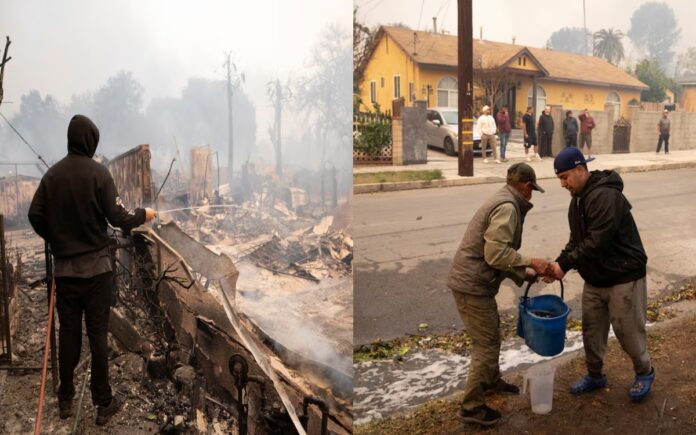Los Angeles: Crews fighting multiple wildfires in Los Angeles on Wednesday faced a dire combination of intense winds, low humidity, and a critical shortage of water to combat the flames.
While municipal water systems in Los Angeles are functioning effectively for urban use, authorities acknowledged that these systems were not designed to address large-scale wildfires.
Wildfires are raging out of control in Los Angeles, destroying hundreds of homes and businesses. A significant fire consumed thousands of acres in Pacific Palisades, a rich neighborhood between Santa Monica and Malibu, home to many musicians and film stars https://t.co/MkBSZF8sbq pic.twitter.com/yyy1cpvC1y
— Reuters (@Reuters) January 9, 2025
At least three significant fires raged simultaneously across Los Angeles County, including one in Pacific Palisades, an affluent coastal neighborhood west of downtown LA, known for multimillion-dollar celebrity homes built along steep canyons.
Jay Lund, a civil and environmental engineering professor at the University of California, Davis, explained the issue: “It’s not a matter of there’s not enough water in Southern California, it’s a matter of there’s not enough water in that particular area of Southern California just for those few hours that you need it to fight the fires.”
The situation forced over 70,000 residents to evacuate, with five fatalities reported. The fires, driven by fierce winds, destroyed hundreds of structures and burned unimpeded since Tuesday.
Mark Pestrella, director of Los Angeles County Public Works, emphasized the strain on the water system: “A firefight with multiple fire hydrants drawing water from the system for several hours is unsustainable.”
Water Demand Outpaces Supply
Janisse Quinones, CEO and chief engineer of the Los Angeles Department of Water and Power, highlighted the challenge of meeting water demands at lower elevations while maintaining supply to refill tanks at higher elevations. The Pacific Palisades fire alone consumed nearly 12,000 acres (4,856 hectares) and exhausted three 1-million-gallon (3.8-million-liter) water tanks by early Wednesday.
Also Read | Pacific Palisades Fire Threatens Iconic Riviera Country Club
“We’re fighting a wildfire with urban water systems, and that is really challenging,” Quinones stated, adding that water demand in Pacific Palisades surged to four times the usual level for 15 hours during the firefight.
In preparation for the windstorm, the Los Angeles Department of Water and Power filled all available water tanks, deploying 18 water trucks carrying 2,000 to 4,000 gallons each to support firefighters. Despite these efforts, the nature of the fires rendered it nearly impossible to arrange sufficient water in advance.
Also Read | Hollywood in Chaos: Wildfires Force Celebrities to Flee, Events Delayed
“If everything catches fire at once, there’s not going to be enough water for everybody,” said Jay Lund. “There’s just no way that you could fit the pipes to work to move that much water across that area in a short period of time.”
Gregory Pierce, director of the UCLA Water Resources Group, noted that the intensity of the fires surpassed typical Southern California standards. His own brother’s house was destroyed in the blaze. He underscored that the challenge lay not in the overall availability of water but in delivering it rapidly to specific locations, a task requiring significant investments in infrastructure and power.
Calls for Proactive Measures
Residents like Sanah Chung, who was seen hosing down hedges and trees outside his Pacific Palisades home, called for stronger preventive measures.
Also Read | Lost Legacy of Queen Hatshepsut: Temple Foundations and Artifacts Revealed
“There must be some things we can do to try to mitigate this. Please. Fire hydrants are empty. Firefighters are doing everything they can, but we need to do things more proactively before,” Chung, 57, told reporters.



